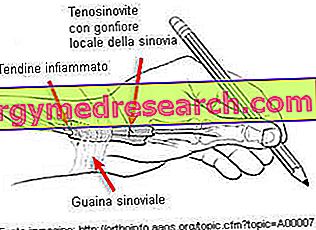What is verdesca?
The verdesca, known in English as " blue shark " (blue shark), is a cartilaginous fish belonging to the Carcharhinidae family and the genus Prionace (species Prionace glauca ).
Verdesca is an edible fish and is part of the group of fish products, or in fishery products; it cannot be bred and is taken "occasionally" by professionals.
From the cartilaginous skeleton of the verdesca various dietary supplements are obtained for the joints and bones (see shark cartilage).

Outline of biology
The verdesca is considered an exponent of the "requiem sharks" (reef sharks or shorelines, which can also attend brackish waters, present in temperate and tropical oceans), even if it prefers cold waters (but is absent in the Arctic Ocean, as well as in Antarctica) and has pelagic attitudes (it migrates, for example, from New England to South America).
It is widespread in the Mediterranean Sea, where it normally lives at a depth of 80-220 m, reaching even 1, 000 m.
Features
Seemingly almost lethargic, because of its slow and calm way of moving, the greenish can move very quickly and make leaps of unsuspected speed.

The maximum duration of life of a verdesca is still unknown but it is assumed that it can be around 20 years.
Ecologically speaking, the verdesca is considered by IUCN a species "almost exposed to threat".
Verdesca and man
The episodes of attack on man are very few, generally not fatal, and linked to chance. It is, however, a duty to report a certain behavioral unpredictability (also with regard to the aforementioned sudden flashes that can take place without warning), especially during reproduction or in moments of food frenzy.
Food
Verdesca as a food
Verdesca is a fish of food interest; it can be eaten fresh, frozen, smoked, salted and dried. It has a very lean meat, white and from which it is easy to obtain slices without thorns.
Together with other sharks, verdesca is one of the most used raw materials as a fraudulent substitute for swordfish. Some call it improperly " sea veal ", which would instead be the common name of the emery.
Rich in protein and low in fat and total calories, it is "apparently" an ideal nutritional solution for:
- Slimming diets
- Nutritional therapies for metabolic disorders
- Who has little confidence in bones, for example children.
However, verdesca is also a product of peach in which mercury is more easily accumulated, which makes it unsuitable for abundant and frequent consumption (especially for children and the elderly).
We recall that the fishing of the verdesca is prohibited. At the amateur level, detention on board of pleasure boats is prohibited, while in the professional sphere, occasional capture is granted (this explains its availability, albeit not constant, on fish stalls).
Note : the other sharks often fished in the Mediterranean Sea and marketed in Italy are: Gattuccio, Gattopardo, Boccanera, Canesca, Palombo, Spinarolo, Smeriglio and Razze. More rarely, Gray shark and Fox shark.
Kitchen
How to prepare verdesca?
There are many recipes based on verdesca.
In the East it is mainly fried or cooked in soy sauce.
In Italy, slices up to 3-4 cm thick are classically cooked in a pan with acquapazza or with wine or milk.
Large pieces of whole fillet can be cooked in the oven, with olives, capers and spices; still in the oven, it is common to bread slices of considerable thickness and season them with aromatic herbs and citrus peel.
In pieces it is a very used ingredient in mixed fried fish or soups.
The stewed verdesca, enriched with vegetables (for example leeks) and plenty of fresh parsley is much appreciated.
It is not particularly suitable for raw consumption. Boiled is not particularly noticeable.
It is advisable to avoid cooking too long in a pan, which tends to make it gummy; different is for soups, which keep it soft.
Nutrition
Nutritional characteristics of verdesca
An excellent source of high biological value proteins, specific vitamins and minerals, verdesca is a food that belongs to the fundamental group of foods.
With its 85 kcal / 100 g, this fish can be considered hypocaloric. Energy is supplied almost exclusively by peptides, which reach 18-19 g / 100 g of edible portion; lipids are just over half a gram and unsaturated fats prevail among fatty acids (almost half of the total are polyunsaturated). Carbohydrates and fibers are absent.
With regard to vitamins, good levels of water-soluble B groups are appreciated such as: thiamine (B1), riboflavin (B2), niacin (PP) and pyridoxine (B6). As far as minerals are concerned, phosphorus and potassium concentrations can be distinguished.
Cholesterol values are not known, which should presumably be low.
It is suitable for all diets, including low-calorie diet and against all metabolic disorders (hypercholesterolemia, hypertriglyceridemia, hypertension, type 2 diabetes mellitus). On the other hand, its frequency of consumption must be limited to "one-off", due to the possible concentration of mercury, such as polluted, which can accumulate in the human body exercising a toxic function.
Verdesca does not contain molecules commonly subject to food intolerance (such as gluten and lactose). For obvious reasons it is not allowed by vegetarian and vegan philosophies.
The average portion is about 100-200 g (85-190 kcal).
Note : some bibliographic sources report very different values and attribute to the verdesca 130 kcal / 100 g; the difference would be the lipid portion, which in any case consists of "good fats" (many EPA and DHA omega 3s).
Hygiene
Hygienic sanitary aspects in the sale of verdesca
The trade of verdesca, like that of the other sharks, is subject to precise rules of hygienic-sanitary safety.
Before buying, especially when the fish is already cut and thawed (without head and therefore without eyes), it is necessary to pay close attention to the visual and olfactory characteristics of the meat; at the slightest hint of ammonia or sulfur, purchase should be avoided.
The verdesca does not suffer in a particularly negative way the freezing, which is why it is advisable to prefer it in this form of conservation.
The following table, extrapolated from the official indications, classifies the freshness level of the whole product (in decreasing order, from extra - which corresponds to the maximum evaluation - up to not admissible - which corresponds to the poorest evaluation).
| CRITERIA | ||||
| FRESHNESS CATEGORY | Not eligible (1) | |||
| Extra | TO | B | ||
| EYE | Convex, very bright and iridescent: small pupils | Convex and slightly sunken; less bright and iridescent, oval pupils | Flat, opaque | Yellowish concave (2) |
| APPEARANCE | Total or partial Rigor mortis; presence of a little clear mucus on the skin | Absent Rigor mortis; absence of mucus on the skin and in particular in the mouth and on the gill openings | A little mucus in the mouth and on the gill openings; slightly flattened jaw | Significant amounts of mucus in the mouth and on the gill openings (2) |
| SMELL | Of seaweed | Without odor or with a very slight smell of stale, but not ammoniacal | Slightly ammoniacal smell; sour | Pungent ammoniacal odor |
(1) This column applies only until the adoption of criteria for fish unfit for human consumption.
(2) Or in a more advanced state of decay.



